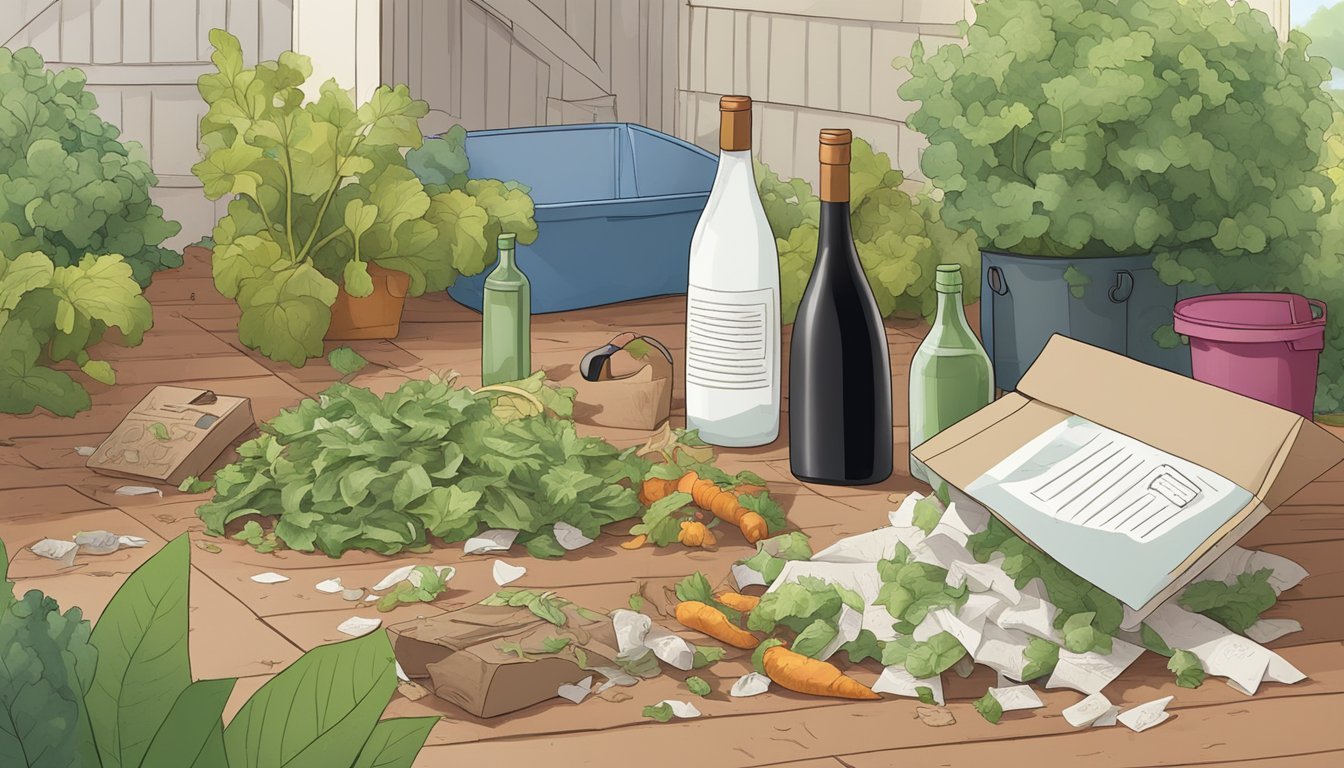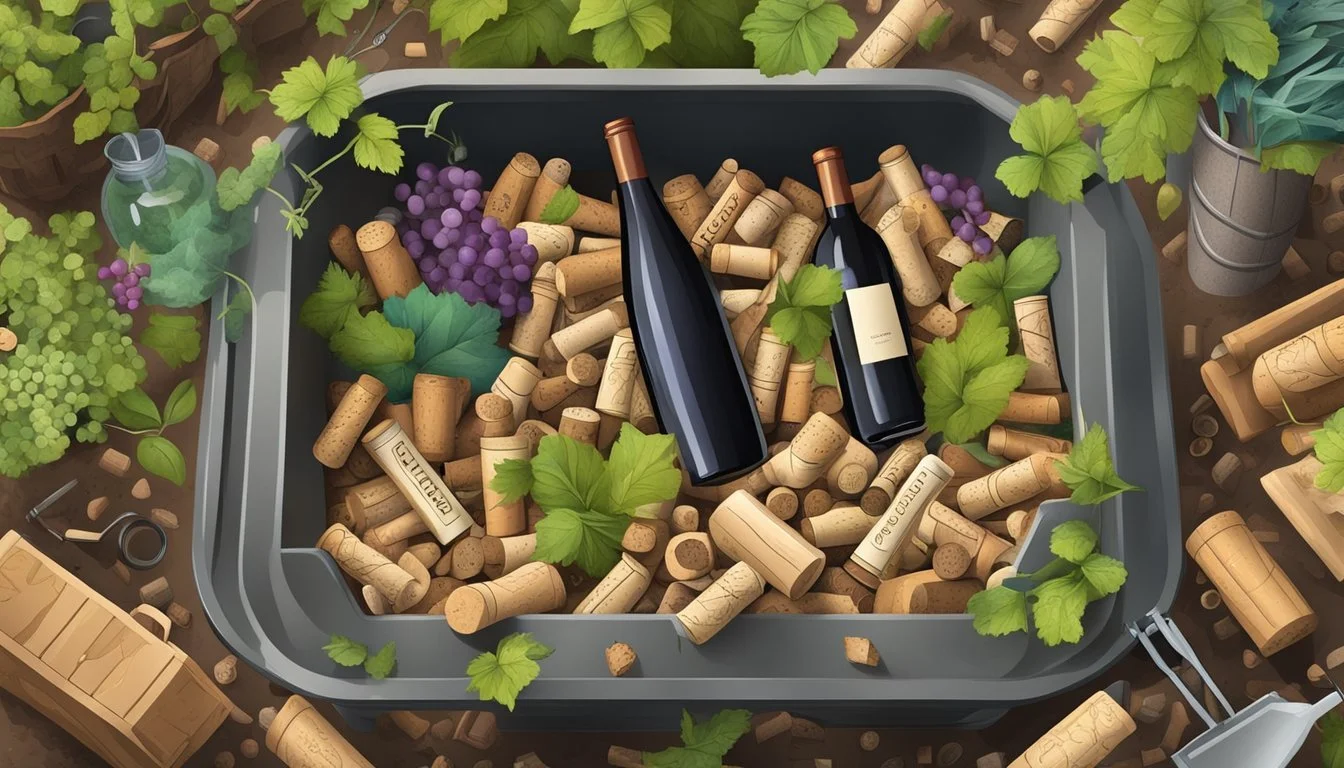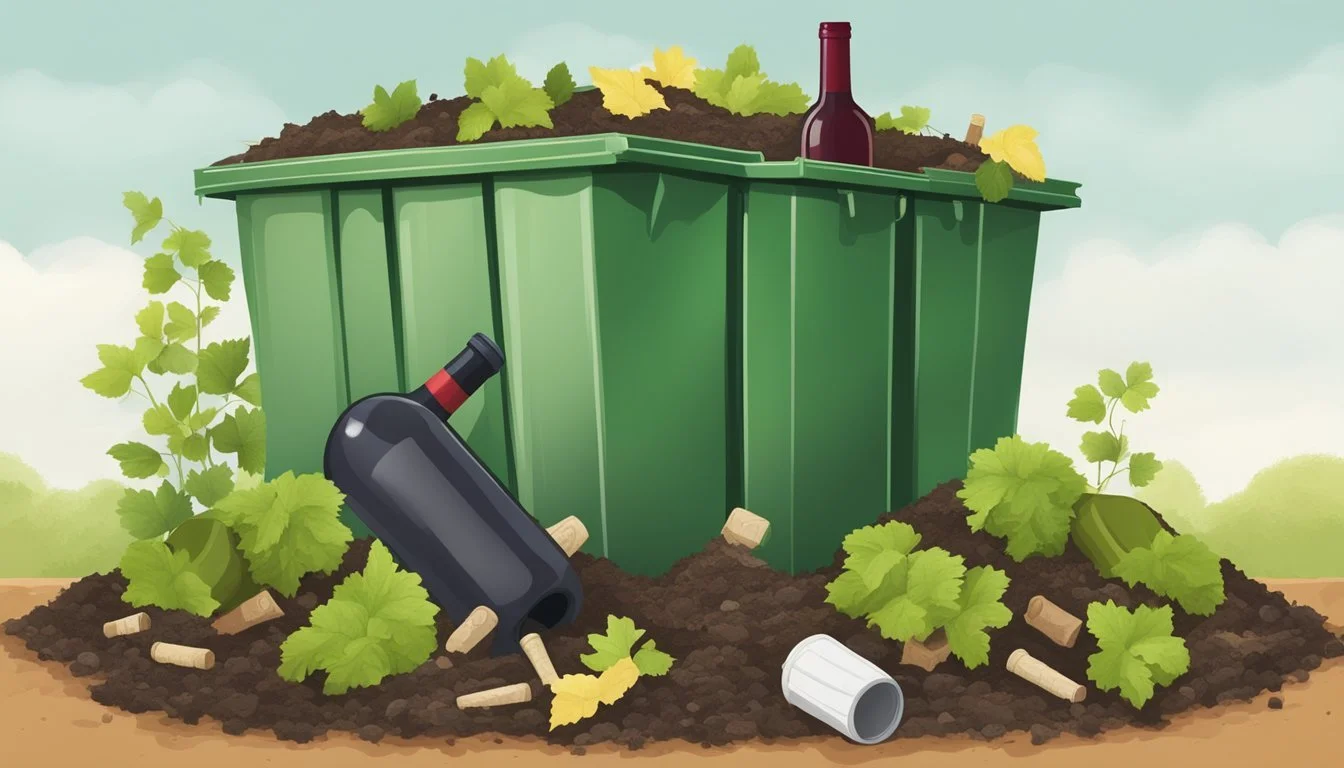Can You Compost Wine Bottles?
Debunking Myths and Explaining Facts
When exploring the environmental impact of wine consumption, one question often comes up: can wine bottles be composted? Traditional glass wine bottles themselves are not compostable due to the material they're made of – glass doesn't decompose like organic matter. However, recycling is a highly effective option for glass bottles, as glass can be melted down and reformed into new products almost indefinitely without losing purity or quality.
The topic of composting takes a more intriguing turn when considering the parts of the wine bottle that are compostable. Natural wine corks, for instance, are made from the bark of cork oak trees and can biodegrade over time. They can be added to compost piles if they are broken down into smaller pieces beforehand, which accelerates their decomposition and integrates them into the resulting nutrient-rich soil amendment.
It's important for compost enthusiasts and wine lovers alike to recognize the distinction between what can be composted and what can be recycled. While wine bottles go to the recycling bin, wine corks can take a turn in the compost heap, contributing to a sustainable cycle of use and reuse. Knowing where each element of a wine bottle should go ensures that the environmental footprint of our wine consumption is as small as possible.
Understanding Composting
Composting transforms organic matter into nutrient-rich humus, benefiting the garden soil. The right mix of green and brown materials, along with moisture and aeration, catalyzes the microbial action required for decomposition.
Composting Basics
Composting is the process of breaking down organic materials into a substance called humus, which is the end result of composted material. A compost pile should be a balanced mix of nitrogen-rich green materials like fruit scraps and carbon-rich brown materials like dried leaves. Composting can be done in a heap in the backyard or a designated compost bin.
Green Materials: Fruit scraps, vegetable waste, coffee grounds
Brown Materials: Dry leaves, branches, cardboard
Decomposition Process
This natural process relies on bacteria, fungi, and other microorganisms to break down organic matter. The rate at which materials decompose depends on the balance of carbon and nitrogen, the presence of microbial action, and the structure of the compost pile, which affects how air and moisture are circulated through the material.
Balance in Compost Pile
For a compost pile to function efficiently, it must maintain a carbon-to-nitrogen ratio of roughly 30:1. Too much nitrogen can cause a compost pile to smell, while too much carbon can slow down the decomposition process.
Optimal Ratio Table:
Nitrogen: 1 part
Carbon: 30 parts
Aerobic Vs Anaerobic Composting
In aerobic composting, air circulation is crucial as oxygen-breathing microbes break down the organic matter, producing minimal odor. In contrast, anaerobic composting occurs in the absence of air, leading to a slower and smell-producing process. Aerobic composting is generally the preferred method for backyard compost piles due to its efficiency and reduced smell.
Aerobic Composting: Requires air, less smell, faster process.
Anaerobic Composting: No air, more smell, slower decomposition.
Maintaining a balance of materials, ensuring proper moisture levels, and facilitating air flow are essential for a healthy composting process.
Recycling and Composting Wine Bottles
Wine bottles, primarily made of glass, offer ample opportunities for recycling and repurposing, contributing to environmental sustainability. While the glass containers can be recycled, natural wine corks can be composted, avoiding landfill waste.
Wine Bottle Composition
Wine bottles are typically made from glass, a material well-suited for recycling due to its durability and the ability to retain quality after processing. Most wine bottles are colored, with green and brown being common hues designed to protect the wine from light, which can affect its quality.
Recycling Wine Bottles
Recycling centers readily accept wine bottles, as glass can be melted and remolded multiple times without losing purity or quality. The process involves:
Collection: Consumers deposit wine bottles at local recycling bins or facilities.
Processing: Collected bottles are cleaned, sorted by color, and crushed into cullet.
Manufacturing: Cullet is melted and used to manufacture new glass products, potentially becoming new wine bottles or other glass items.
Benefits of recycling wine bottles include:
Environmental: Reduced energy consumption and greenhouse gas emissions compared to making new glass from raw materials.
Conservation: Conserves natural resources by decreasing the demand for new raw materials.
Landfill Space: Decreases the volume of waste sent to landfills.
Repurposing Wine Bottles
Repurposing or reusing wine bottles provides an eco-friendly alternative to recycling, giving the bottles a new life as:
Decorative items, like candle holders or vases
Building materials, such as in glass bottle walls
Individuals and businesses alike can repurpose wine bottles creatively, enhancing their environmental impact by reducing the need for new resources and minimizing waste.
Can You Compost Wine Bottles?
Composting is typically reserved for organic materials that break down over time. Wine bottles, on the other hand, are made of glass, which does not degrade in a composting environment.
Challenges with Wine Bottles
Wine bottles pose several challenges to the composting process. Unlike organic waste, glass does not break down and decompose through natural biological processes. Glass is inert, meaning it will remain in the compost indefinitely without altering its state. Composting, which relies on the activity of microorganisms to break down organic materials, is not an effective method for dealing with wine bottles.
Here are the primary issues with attempting to compost wine bottles:
Non-Degradable: Glass is non-biodegradable and will not break down into simpler compounds that can nourish the soil.
Safety Concerns: Broken glass can pose safety risks to humans and animals if incorporated into compost.
Alternatives to Composting Bottles
Although wine bottles cannot be composted, they are highly recyclable. Glass bottles can be endlessly recycled without loss of purity or quality. Recycling facilities melt down the glass and reform it into new products, conserving resources and reducing waste.
Consider these alternatives to composting for wine bottles:
Recycling: Check local recycling guidelines to ensure proper disposal.
Upcycling: Turn wine bottles into decorative items or practical tools.
Glass wine bottles should be directed towards recycling streams rather than compost bins. By recycling, individuals prevent the material from ending up in landfills and contribute to the creation of new glass products.
Decomposing Wine Corks
When considering the incorporation of wine corks into compost, it's crucial to differentiate between natural cork and synthetic cork varieties due to their varying decomposing properties and impacts on compost quality.
Types of Wine Corks
Natural Corks: These corks are harvested from the bark of the cork oak tree and are biodegradable. They can be a woody addition to the compost, providing beneficial structure.
Synthetic Corks: Contrary to natural corks, synthetic variations are made from plastic compounds and do not break down readily in a composting environment. As such, they should be kept out of the compost bin.
Natural Cork Decomposition
Natural corks are composed of a complex structure of suberin and lignin which, while organic and biodegradable, decompose at a slow rate. They can be composted but may need to be cut into smaller pieces to aid in this process. Bacteria and other organisms within a compost system gradually break down these pieces, but patience is required.
Synthetic Cork Challenges
Synthetic corks do not decompose in a compost setup due to their plastic content. They are not suitable for composting and should be considered for recycling or other forms of eco-friendly disposal. Incorporating synthetic corks into compost can interfere with the quality and usability of the end product.
Effective Composting Practices
Effective composting hinges on the management of several key factors that determine the success of decomposition within a compost pile. These include the temperature of the composting materials, moisture levels, aeration, and the avoidance of non-compostable materials.
Hot Composting Method
Hot composting is an efficient method to accelerate decomposition. It requires maintaining a compost pile at temperatures between 135°F and 160°F. This is achieved by layering green materials, like food scraps, with brown materials, such as dry leaves or straw, to create a balanced mix of nitrogen and carbon. Regular turning of the pile and monitoring the temperature ensure optimal breakdown of organic material, converting it into rich compost quicker than traditional methods.
Adjusting Moisture and Aeration
For compost to decompose effectively, maintaining the correct moisture and aeration levels is crucial. A compost pile should have the moisture content of a wrung-out sponge. If too wet, add dry, brown materials; if too dry, add water or green materials. Moreover, the compost requires oxygen to support the microorganisms that break down the organic matter. Turn the pile regularly to introduce air and prevent anaerobic conditions, which can cause unpleasant odors and slow down the composting process.
Avoiding Non-Compostable Materials
Care should be taken to exclude materials that do not decompose or may introduce harmful substances into the compost. Items such as plastic, styrofoam, and synthetic corks do not break down and should not be added to compost bins. Conversely, materials like natural cork can be composted but they decompose slowly and may need to be broken into smaller pieces. It is also important to note that while vermicompost methods can handle smaller amounts of organic matter, traditional compost bins are better suited for larger volumes.
Composting Tips for Home and Garden
In creating a thriving compost for your garden, understanding the balance of materials and maintenance is crucial. The following tips shed light on turning kitchen and garden waste into nutrient-rich soil amendments.
Utilizing Brown and Green Materials
A healthy compost pile requires an appropriate balance of brown and green materials—the browns for carbon and the greens for nitrogen. Brown materials include dry leaves, twigs, and shredded paper, whereas green materials encompass fruit and vegetable scraps, coffee grounds, and grass clippings. An effective ratio is 3 parts brown to 1 part green.
Brown Materials (Carbon-rich):
Dry leaves
Twigs
Shredded paper
Green Materials (Nitrogen-rich):
Fruit and vegetable scraps
Coffee grounds
Grass clippings
Maintaining a Healthy Compost Structure
Compost should maintain a damp sponge-like texture, achieved by layering and regular watering. Start with a layer of brown material, add green material, and top with a layer of soil. Introducing waste such as eggshells, which should be crushed using a kitchen grater to increase surface area, adds beneficial calcium to the mix. Conversely, items like meat should be excluded to prevent pests and unpleasant odors.
Structure and Consistency Tips:
Alternate layers of brown and green materials
Keep the compost as moist as a wrung-out sponge
Crush eggshells before adding for better decomposition
Using Compost in Gardens
When compost transforms into a dark, carbon-rich humus, it's ready to benefit the garden. Work it into the soil of garden beds to improve fertility and structure, or use as a mulch to retain moisture and suppress weeds. Potted plants can also flourish with a top-dressing of compost for a slow release of nutrients.
Incorporation Methods:
Blend into garden beds to enrich soil
Apply as mulching material around plants
Top-dress potted plants to nourish over time
Preventing Pests and Odors
A well-maintained compost pile should not attract pests or emit bad smells. Prevent these issues by covering new additions with a layer of soil or dry brown material and by turning the pile regularly to aerate it. Never add boiling or cooked waste, as it can attract unwanted rodents and insects.
Prevention Measures:
Cover additions with soil or dry brown material
Regularly turn the pile to introduce oxygen
Avoid adding cooked or boiling waste
Innovative Uses for Wine Corks and Bottles
Turning wine corks and bottles into creative and eco-friendly DIY projects not only contributes to recycling efforts but also fosters sustainability. They can be repurposed in various ways that excel in both function and aesthetic appeal.
Cork Re-purposing Ideas
Wine corks, especially those made of real cork, are a renewable resource that can be transformed into practical items. They can be cut and shaped into cork tiles for bulletin boards, or sliced into thin discs to serve as plant pot coasters. The Cork Forest Conservation Alliance highlights the environmental importance of reusing cork products, as it prevents unnecessary waste and supports the preservation of cork forests.
Key Holder: Glue corks to a flat surface and add hooks to create a unique, rustic key holder.
Cork Board: Arrange a variety of corks in a frame for a custom cork bulletin board.
Wine Bottle DIY Projects
Empty wine bottles provide a sturdy and attractive material for a wide range of creative DIY endeavors. An empty wine bottle can be meticulously cut to create drinking glasses or candle holders. As a construction material, wine bottles can be repurposed into sustainable building elements, such as glass-brick windows that provide both light and insulation.
Light Fixtures: Fitted with LED string lights, wine bottles can be converted into decorative light fixtures.
Garden Edging: Lined up along garden paths, bottles offer a long-lasting, colorful edge solution.
Environmental Impact
When assessing the environmental impact of wine bottles, it is essential to consider how methods like composting and recycling can support conservation efforts, reduce landfill waste, and promote eco-friendly practices.
Conservation and Sustainability
Composting wine bottles, when referring to the decomposable corks, supports sustainable practices by potentially diverting waste from landfills and contributing to soil enrichment. Cork is a renewable resource harvested from cork trees without felling them, aligning with the goals of the Cork Forest Conservation Alliance which advocates for preserving cork forests and the biodiversity they support.
Reducing Landfill Waste
Recycling glass bottles and corks can significantly reduce landfill waste. Glass is endlessly recyclable without loss of purity or quality, while natural corks can be composted as organic materials. Many recycling programs now encourage the recycling of wine bottles to minimize the environmental footprint.
Supporting Eco-Friendly Practices
Opting for eco-friendly practices, such as recycling wine bottles or composting corks, leads to positive environmental outcomes. Manufacturers who use FSC-certified corks and consumers who participate in recycling programs contribute to a cycle of sustainability, emphasizing the importance of environmentally friendly methods in the wine industry.
Conclusion
When considering the compostability of wine bottles, it's important to distinguish between the materials involved: glass and cork. Glass from wine bottles is not suitable for composting; it is an inert material that does not break down in a compost pile. Instead, recycling is the best option for glass wine bottles, as it conserves resources and reduces landfill waste.
In contrast, wine corks can be a compostable material. Genuine corks made from the bark of cork oak trees are organic and decompose over time. However, the decomposition rate for natural cork in a compost pile is slow, so cutting corks into smaller pieces before adding them to compost is beneficial.
When adding wine corks to compost, the following tips should be noted:
Ensure corks are natural cork, not synthetic.
Chop or shred corks to speed up the decomposition process.
Balance with other green and brown materials in the compost to maintain a healthy compost pile.
In summary, wine corks may contribute to a nutrient-rich compost, but wine bottles should be directed towards recycling programs. Proper disposal practices for these components align with sustainable waste management and environmental conservation efforts.








